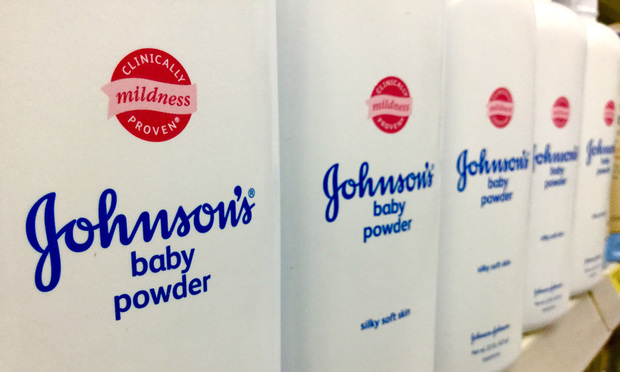J&J Faces Trial in 'Home' Court Over Talc's Link to Mesothelioma
Johnson & Johnson goes on trial Monday in Middlesex County, New Jersey Superior Court in a suit claiming inhaled asbestos from its talc products caused a man to develop mesothelioma.
January 24, 2018 at 04:05 PM
4 minute read

Johnson & Johnson goes on trial Monday in Middlesex County, New Jersey Superior Court in a suit claiming inhaled asbestos from its talc products caused a man to develop mesothelioma.
The upcoming trial, in a suit filed by plaintiff Stephen Lanzo III of Verona is the second in which asbestos from Johnson & Johnson's talc products is alleged to have caused a user to develop mesothelioma. The first trial in the nation to link J&J products to mesothelioma, the case of Tina Herford, ended in a defense verdict in November 2017 in Los Angeles Superior Court.
The Middlesex County Courthouse, site of next week's trial, is only a few blocks from Johnson & Johnson's world headquarters in New Brunswick. Superior Court Judge Ana Viscomi is set to preside at the trial, which is expected to run for two months.
But while Johnson & Johnson can still claim the upper hand in litigation linking its talc products to mesothelioma, its track record is less successful in suits by women who claim they developed ovarian cancer after using J&J talc products for feminine hygiene.
In 2016, plaintiffs obtained three verdicts against the company—$55 million, $70 million and $72 million—in suits linking talc to ovarian cancer. In 2017, J&J saw one defense verdict in talc litigation, and two verdicts for plaintiffs—$110 million and $417 million. Two of the ovarian cancer verdicts, for $72 million and $417 million, have been reversed.
The trial had been slated to begin Jan. 22 but Viscomi told jurors to come back in a week while the parties deal with a last-minute evidentiary dispute. Lanzo claims his only probable exposure to asbestos is from Johnson's Baby Powder, but J&J says it has a tissue sample from the plaintiff showing the presence of a type of asbestos associated with other commercial products. However, Viscomi would not let the drug company admit the evidence because it was not served on a timely basis.
On Monday, J&J moved to stay the trial pending an interlocutory appeal, but Viscomi denied the request. But she later agreed to put the trial off for a week while the parties address the evidentiary dispute. Lawyers for both sides then continued their discussion of the dispute in the judge's chambers.
Lanzo's suit claims J&J knew that its products contained asbestos but failed to warn consumers. The company, for its part, maintains that its products never contained asbestos, and maintain that the plaintiffs have used faulty test methods.
Lanzo is represented by Moshe Maimon of Levy Konigsberg in New York. Johnson & Johnson is represented by Drinker Biddle & Reath and Kirkland & Ellis.
In addition to Johnson & Johnson and Johnson & Johnson Consumer Cos., the defendants in the case include Imerys Talc America and Cyprus Amax Minerals Co.
In Herford's case in Los Angeles, J&J scored a victory after arguing that asbestos exposure from other sources—such as therapeutic radiation treatments and clothing worn by her father, who was exposed to asbestos at his job—may have caused Herford's mesothelioma.
But the lead plaintiff's counsel in Herford's case, Chris Panatier of Dallas-based Simon Greenstone Panatier Bartlett, said the defense verdict would have little effect on future trials.
“The talc/asbestos case is extremely complicated, dealing with all manner of microscopic techniques and mineralogy etc.,” he said. “It's our job to make all of that accessible and though I tried to do that, perhaps it wasn't enough. Also, from my conversations with a few of the jurors, it sounded like this simply was not a jury that was going to find for a plaintiff. I accept that. It happens.”
This content has been archived. It is available through our partners, LexisNexis® and Bloomberg Law.
To view this content, please continue to their sites.
Not a Lexis Subscriber?
Subscribe Now
Not a Bloomberg Law Subscriber?
Subscribe Now
NOT FOR REPRINT
© 2025 ALM Global, LLC, All Rights Reserved. Request academic re-use from www.copyright.com. All other uses, submit a request to [email protected]. For more information visit Asset & Logo Licensing.
You Might Like
View All
On the Move and After Hours: Einhorn Barbarito; Gibbons; Greenbaum Rowe; Pro Bono Partnership
4 minute read

Engine Manufacturer Escapes Suit Over NJ Helicopter Crash That Killed Country Music Star
3 minute readTrending Stories
- 1Microsoft Becomes Latest Tech Company to Face Claims of Stealing Marketing Commissions From Influencers
- 2Coral Gables Attorney Busted for Stalking Lawyer
- 3Trump's DOJ Delays Releasing Jan. 6 FBI Agents List Under Consent Order
- 4Securities Report Says That 2024 Settlements Passed a Total of $5.2B
- 5'Intrusive' Parental Supervision Orders Are Illegal, NY Appeals Court Says
Who Got The Work
J. Brugh Lower of Gibbons has entered an appearance for industrial equipment supplier Devco Corporation in a pending trademark infringement lawsuit. The suit, accusing the defendant of selling knock-off Graco products, was filed Dec. 18 in New Jersey District Court by Rivkin Radler on behalf of Graco Inc. and Graco Minnesota. The case, assigned to U.S. District Judge Zahid N. Quraishi, is 3:24-cv-11294, Graco Inc. et al v. Devco Corporation.
Who Got The Work
Rebecca Maller-Stein and Kent A. Yalowitz of Arnold & Porter Kaye Scholer have entered their appearances for Hanaco Venture Capital and its executives, Lior Prosor and David Frankel, in a pending securities lawsuit. The action, filed on Dec. 24 in New York Southern District Court by Zell, Aron & Co. on behalf of Goldeneye Advisors, accuses the defendants of negligently and fraudulently managing the plaintiff's $1 million investment. The case, assigned to U.S. District Judge Vernon S. Broderick, is 1:24-cv-09918, Goldeneye Advisors, LLC v. Hanaco Venture Capital, Ltd. et al.
Who Got The Work
Attorneys from A&O Shearman has stepped in as defense counsel for Toronto-Dominion Bank and other defendants in a pending securities class action. The suit, filed Dec. 11 in New York Southern District Court by Bleichmar Fonti & Auld, accuses the defendants of concealing the bank's 'pervasive' deficiencies in regards to its compliance with the Bank Secrecy Act and the quality of its anti-money laundering controls. The case, assigned to U.S. District Judge Arun Subramanian, is 1:24-cv-09445, Gonzalez v. The Toronto-Dominion Bank et al.
Who Got The Work
Crown Castle International, a Pennsylvania company providing shared communications infrastructure, has turned to Luke D. Wolf of Gordon Rees Scully Mansukhani to fend off a pending breach-of-contract lawsuit. The court action, filed Nov. 25 in Michigan Eastern District Court by Hooper Hathaway PC on behalf of The Town Residences LLC, accuses Crown Castle of failing to transfer approximately $30,000 in utility payments from T-Mobile in breach of a roof-top lease and assignment agreement. The case, assigned to U.S. District Judge Susan K. Declercq, is 2:24-cv-13131, The Town Residences LLC v. T-Mobile US, Inc. et al.
Who Got The Work
Wilfred P. Coronato and Daniel M. Schwartz of McCarter & English have stepped in as defense counsel to Electrolux Home Products Inc. in a pending product liability lawsuit. The court action, filed Nov. 26 in New York Eastern District Court by Poulos Lopiccolo PC and Nagel Rice LLP on behalf of David Stern, alleges that the defendant's refrigerators’ drawers and shelving repeatedly break and fall apart within months after purchase. The case, assigned to U.S. District Judge Joan M. Azrack, is 2:24-cv-08204, Stern v. Electrolux Home Products, Inc.
Featured Firms
Law Offices of Gary Martin Hays & Associates, P.C.
(470) 294-1674
Law Offices of Mark E. Salomone
(857) 444-6468
Smith & Hassler
(713) 739-1250







